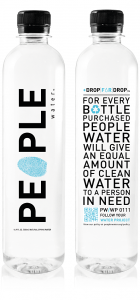Narissa recently wrote about the prevalence of water in different products, including paint and soft drinks, as well as the idea of reducing the environmental impact of transporting goods that contain a lot of water. She does a great job with challenging the conventional make-up of everyday products. While there are clear, valid arguments in her post, some of the ideas may be somewhat unrealistic. There’s something about moving towards powder-based products that seems both archaic (but not in a farm-to-table kind of way, but rather, a “green” spin on Kool-Aid/Tang) and current/modern (protein shakes ftw!), which presents an interesting dichotomy for consumers. It may also open the doors for a range of companies to claim that their products are more sustainable, given the form that they’re in, without articulating the environmental effect of the particular ingredients/how they are harvested.
Alternatively, to reduce the environmental impact of transporting water-heavy products, maybe companies need to adopt improved supply-chain management operations. Shipping less frequently, but in larger amounts, along the lines of a Just-In-Time system would reduce carbon emissions and (possibly) transportation costs. Efficiency and sustainability; what a happy combo!
This next part of my post is somewhat related, as it talks about water, but it also presents some conflicting notions on sustainability.
In an earlier blog post from this term, I wrote about the Triple Bottom Line concept. While researching different bottled water companies, I came across the brand, People Water. This is a for-profit, cause-based business, committed to alleviating the global water crisis. They do this through their Drop-For-Drop initiative. Think TOMS, but with bottled water, and well-drilling initiatives in impoverished nations with limited access to clean water.
After perusing through their website, what I found interesting was their clear articulation of subscribing to a Double Bottom Line concept, which considers Profit and People/Social elements. They don’t necessarily ignore the Planet pillar of the triple bottom line concept (even claiming to use mostly eco-friendly plastic water bottles…), but their not fully embracing it either (which is probably best, given the nature of the product). Without a doubt, this company has developed amazing integrated marketing communications; just look at that bottle! On the other hand of course, the whole concept of bottled water is not particularly sustainable (yet the practice of providing clean water to everyone is…).
So what do you think? Is 2/3 good enough with regards to the triple bottom line? Is People Water just another example of a for-profit capitalizing on socially-minded consumers? Is the title of this post as lame as I intended it to be?

